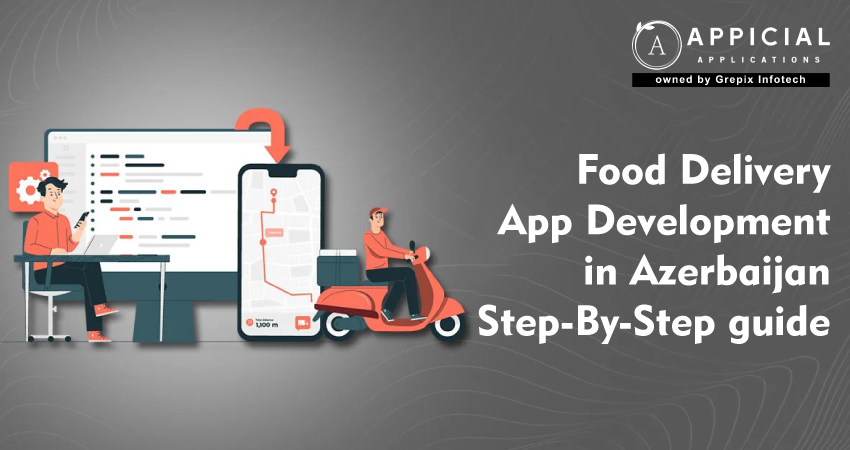
Food delivery app development in Azerbaijan step-by-step guide
If you’ve ever walked around Baku at lunchtime, you know the streets are buzzing. Offices, schools, and shops are crowded. People are constantly checking their phones. And why not? With so much going on, ordering food online has become a necessity.
I remember my first time using a food delivery app in Baku. I was running late for a meeting, hungry, and stressed. Within a few taps, a warm meal was on its way. That kind of convenience is why apps like DoorDash food delivery and Grubhub delivery are globally popular. Locally, the market is catching up fast.
Smartphones are everywhere. About 80% of adults in urban areas use one daily. Internet connectivity is solid, and people are willing to pay for convenience. If you’re thinking about food delivery app development in Azerbaijan, this is the moment to act.
In Azerbaijan, life is busy, and people want meals delivered fast. This guide walks you through food delivery app development in Azerbaijan, with practical tips, local insights, and real stories. See how Appicial Applications helped a Baku restaurant streamline delivery, and learn how you can build a successful DoorDash delivery app style or local food ordering app.
Why Delivery Apps Are So Popular?
Azerbaijanis love good food. But they also value time. Between work, commuting, and family, cooking isn’t always practical. Food ordering apps solve this problem. They bring a variety of meals right to your doorstep.
Local surveys show that 60-65% of urban residents prefer ordering online to calling restaurants. It’s faster, more flexible, and often cheaper. For businesses, it’s an opportunity to expand their customer base without opening more outlets.
Who Are the Competitors?
International players like Grubhub delivery and the DoorDash delivery app in Azerbaijan are well-known. But they aren’t dominating Azerbaijan. Local startups and smaller delivery apps are gaining traction. Some specialize in lunch delivery for offices; others focus on gourmet meals. Understanding the competition is key if you want your app to stand out.
What Users Want from a Food Delivery App in Azerbaijan?
Users care about speed, reliability, and variety. They want:
- Fast delivery, often in 30 minutes or less
- Easy payment options (card, wallet, or cash)
- Real-time tracking of their orders
- Menus that are simple to browse
- Discounts and promotions
Meeting these needs is more important than fancy features. If users can’t trust your app to deliver quickly and correctly, they won’t come back.
Step-by-Step Guide to Food Delivery App Development
1 Understand Your Users
Ask yourself: who are you building this app for? Office workers? Students? Families?
I remember talking to a Baku café owner who struggled with order chaos. Most of his customers were office employees wanting lunch delivered quickly. Understanding this shaped the features of the app we helped build: quick order buttons, pre-saved addresses, and express delivery options.
2 Decide on Core Features
A practical food delivery app in Azerbaijan should include:
- Profiles for users to save addresses and payment methods
- Menus with images and clear descriptions
- Order management with easy modifications
- Payment options include card, wallet, and cash
- Delivery tracking
- Ratings and reviews for restaurants
- Notifications for order updates and promotions
These are basic, but they solve real problems and improve user experience.
3 Choose Technology Carefully
The tech stack matters. For cross-platform apps, Flutter or React Native works well. Backend can be Node.js, Python, or Java. Database options include PostgreSQL or MongoDB. And secure payment integration is a must; users won’t trust an app that loses their card info.
4 Focus on Design and Usability
I’ve noticed that human intuition plays a huge role in app design. Can someone place an order in 60 seconds? Are menus readable? Buttons obvious?
Small local touches matter too. Using Azerbaijani colors, cultural visuals, or even local dish names makes the app feel familiar and trustworthy.
5 Development and Testing
Development should happen in stages: prototype, build, test. Human testers catch things machines can’t—confusing buttons, slow pages, or unclear navigation.
We worked on a local app where testing revealed a simple but critical issue: users were canceling orders accidentally because the button placement was confusing. Fixing it increased retention.
6 Launch and Marketing
Launching isn’t just uploading the app. Partner with local influencers, run social campaigns, and offer launch promotions. SEO matters too. Make your app visible on Google and app stores using natural mentions of food delivery apps, DoorDash delivery apps, or food ordering apps in Azerbaijan.
Feedback after launch is gold. Monitor, iterate, and improve constantly. Human attention beats automation every time.
Also Read: Seychelles Food Delivery Business: How to Enter the Market Successfully
Real Case Study – Appicial Applications in Action
The Challenge
A small restaurant in Baku struggled to handle phone orders. Customers often received wrong orders. The staff was overwhelmed.
The Solution
Appicial Applications built a custom food delivery app in Azerbaijan with:
- Real-time tracking for users
- Integrated payment options
- Clean interface for ordering
- Dashboard for restaurant staff
The Result
- Orders increased by 40%
- Delivery times shortened
- Customer satisfaction rose
The human approach, talking to staff, understanding customer pain points, made the app truly effective.
Conclusion
Azerbaijan’s food delivery market is ready for growth. Success comes to those who understand users and approach development thoughtfully.
Appicial Applications combines technical skill with human insight. Whether you want a DoorDash delivery app experience, compete with Grubhub delivery, or create a unique local food ordering app in Azerbaijan, they make it happen.
Focus on real problems, listen to users, and design for humans, not algorithms. That’s how you win.
FAQs
Author's Bio

Vinay Jain is the Founder at Grepix Infotech and brings over 12 years of entrepreneurial experience. His focus revolves around software & business development and customer satisfaction.
Back to blog list




